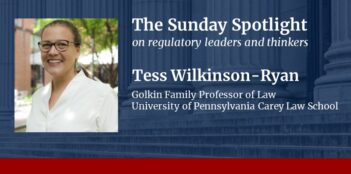
Citizens are more likely to comply with regulations that they perceive as enacted through a fair process.
How can regulatory policymakers create regulations that citizens will trust and accept?
As Nobel Laureate Richard Thaler and others have shown, regulators can draw on the findings from psychological studies to craft regulations that will prompt or “nudge” citizens to make better decisions. Another branch of psychological science, however, also can contribute in vital ways to regulatory policy and administration by making it more likely that citizens will accept regulations and comply with administrative decisions.
This latter body of work, which is generally termed “the psychology of procedural justice,” focuses not on the content of regulations, but rather on the process by which regulations are designed, implemented, and administered. Field studies, policy experiments, and laboratory research dating back to the early 1970s—reinforced by very recent studies on the neuroscience of social behavior—show that acceptance of rules, compliance with regulations and administrative decisions, and trust in government are all improved if regulatory processes incorporate elements that enhance perceived fairness.
Scholars studying the psychology of reactions to judicial, administrative, and organizational procedures have found that subjective perceptions of process fairness can strongly impact citizens’ thoughts and behavior. Studies show that attitudes toward laws and regulations as well as behavioral compliance with regulatory decisions are often as strongly affected by citizens’ experiences with and perceptions of the process as they are by the outcomes they experience.
Even in the face of costs or other negative outcomes from a regulatory scheme, citizens’ perceptions of fair process in the design and administration of the regulations enhance acceptance and compliance. Studies show an additional benefit of perceived procedural fairness: a direct increase in overall trust in government.
The link between perceived process fairness and acceptance of rules and decisions appears to arise from human social motivation—a fundamental determinant of human behavior that complements self-interest motives. Feeling that you have been fairly treated elicits a sense of inclusion, whereas experiencing unfairness produces feelings of exclusion.
Recent studies in social neuroscience, which use functional magnetic resonance imaging technology to examine how the human brain reacts to fairness and inclusion—versus unfairness and exclusion—have shown that fairness prompts reactions in pleasure centers of the brain, whereas unfairness and exclusion prompt reactions in pain centers. Thus, both traditional social psychological studies and neuroscience studies suggest that a strong reaction to perceived fairness or unfairness is deeply entrenched in human psychology.
Of course, the law has a long history recognizing that fairness and justice reside not only in outcomes and decisions, but also in legal process. If citizens’ impressions of fairness influence their reactions to legal and regulatory procedures, regulatory policymakers must not only enact fair procedures, but also show citizens that a fair process was enacted and followed. The factors that researchers have identified to drive perceptions of fair or unfair treatment in encounters with the regulatory process will be familiar to those trained in law, but each factor requires additional attention or modification to bring it into line with the psychology of fairness.
Researchers have shown four factors to promote positive procedural justice judgments: voice, or the perception that one’s views are heard and considered; lack of bias; explanations of the process and decisions; and dignified and respectful treatment.
The first three factors correspond roughly to legal criteria of representation and consultation, neutrality, and comprehension and decision justification; the fourth factor corresponds to the ethical principle of respect for persons.
Citizens must perceive each element for it to affect their judgment of fairness. This means that regulatory policymakers and administrators must enact each element in ways that create an impression of fairness in the persons who are making judgments of fairness. It is not enough to allow consultation or to enforce neutrality, for example. To glean the considerable benefits of perceived fairness, regulatory policymakers and administrators must take care to demonstrate process fairness. This is often not the case.
An Organization for Economic Cooperation and Development (OECD) survey that examined regulatory processes in 34 nations and the European Commission shows that, although most countries mandate public consultation on primary laws and subordinate regulations—and thus provide an objective opportunity for voice—only in a minority of the countries studied did regulators respond directly to those who commented. Officials in these latter nations demonstrated subjective voice by showing that they had considered the comments they received.
In the end, the evidence is clear that regulatory officials can create regulations that citizens will trust and accept—but only by actively demonstrating that they adhere to core principles of procedural justice.
The opinions expressed and arguments employed are those of the authors and do not represent the official views of the OECD or of its member countries. All results of the survey discussed in this essay, as well as further analysis, can be found in the OECD 2015 Regulatory Policy Outlook and in the complementary analytical paper. For further information on these topics, and a longer list of relevant work, see Lind and Arndt’s recent paper, “Perceived Fairness and Regulatory Policy: A Behavioral Science Perspective on Government-Citizen Interactions.”





